Coaching Corner
Know, Understand, and Implement Effective Mathematics Teaching and Learning
Essential Coaching Action 7 is to know, understand, and implement effective mathematics teaching and learning. Coaches work with teachers and teams to faciliate the design of standards-based lessons which include specific learning outcomes, cognitively demanding tasks, engaging mathematical experiences and aligned assessments. Coaching focuses on improving lesson design and implementation of the lesson to increase student’s mathematical competency.
- Develop a quality lesson planning process
- Build capacity for effective instructional strategies and task implementation
- Grow pedagological content knowledge
Mathematics Practices Teaching Continuum. This tool can help a shool leader see what a student centered classroom looks like. This can be used so teachers can set goals to help develop an understanding of the mathematical teaching practices.
What does it mean to be an inquiry-based teacher? Read through the following lists of characteristics of an inquiry-based teacher and their accompanying descriptions. Think about what each one means to you and evaluate how well it describes you as a teacher. Analyze each characteristic using the following directions.
- Self-Assessment Inventory: Inquiry-Based Teaching
- Self-Assessment Inventory:Inquiry-Based Teaching – Description
A lesson planning tool used to plan for instruction for an essential standard.
Reproducible from NCSM Essential Action Series: Framework for Leadership in Mathematics Education for coaches and teachers/teams to plan for student learning in a unit.
Teachers shifted their emphasis from developing student independent seatwork to developing thought-provoking questions during instruction by participating in professional development that had them engage in important discussion questions. Listen to Marcy Meyers, mathematics resource teacher from Carroll County Public Schools share how to help facilitate this shift and the discussion questions she utilized.
Joan Tellish, math support teacher from Howard County Public Schools System, describes how having teachers develop and use a set of talk "tools" in mathematics led to a school-wide adoption of these "tools" in every discipline. The resultant impact of this consistent use of "tools" on respectful discourse throughout all the classrooms is compelling.
Listen or read a story from Rhina Odom, First Grade Teacher & Math Team Lead, Lonoke Primary School describe the positive effects of student-centered learning through constructive classroom conversations and co-teaching and how these have changed the way teachers approach teaching.
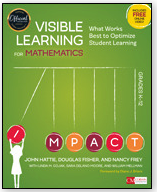 Rich tasks, collaborative work, number talks, problem based learning, direct instruction…with so many possible approaches, how do we know which ones work the best? In Visible Learning for Mathematics, six acclaimed educators assert it’s not about which one―it’s about when―and show you how to design high impact instruction so all students demonstrate more than a year’s worth of mathematics learning for a year spent in school.
Rich tasks, collaborative work, number talks, problem based learning, direct instruction…with so many possible approaches, how do we know which ones work the best? In Visible Learning for Mathematics, six acclaimed educators assert it’s not about which one―it’s about when―and show you how to design high impact instruction so all students demonstrate more than a year’s worth of mathematics learning for a year spent in school.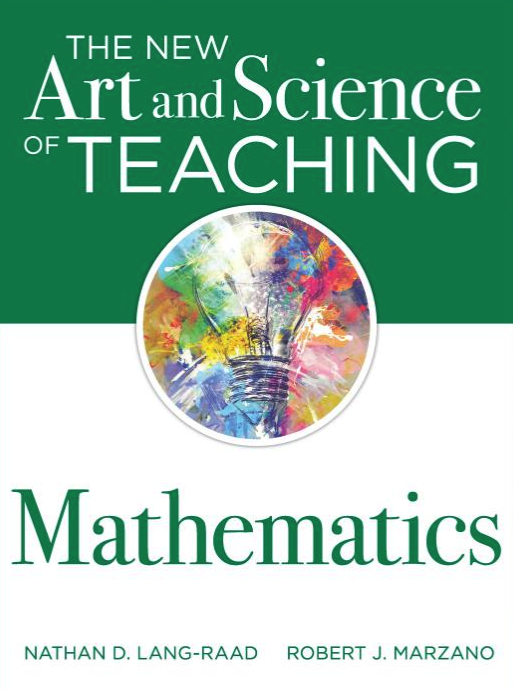 In The New Art and Science of Teaching Mathematics, authors Nathan D. Lang-Raad and Robert J. Marzano reenvision the groundbreaking New Art and Science of Teaching framework for math classrooms. Readers will discover myriad math strategies, tools, and methods of teaching mathematics for every step of the process, from articulating learning targets and conducting math lessons to engaging students, tracking progress, and celebrating successes.
In The New Art and Science of Teaching Mathematics, authors Nathan D. Lang-Raad and Robert J. Marzano reenvision the groundbreaking New Art and Science of Teaching framework for math classrooms. Readers will discover myriad math strategies, tools, and methods of teaching mathematics for every step of the process, from articulating learning targets and conducting math lessons to engaging students, tracking progress, and celebrating successes. The same five practices teachers know and love for planning and managing powerful conversations in mathematics classrooms, updated with current research and new insights on anticipating, lesson planning, and lessons learned from teachers, coaches, and school leaders.
The same five practices teachers know and love for planning and managing powerful conversations in mathematics classrooms, updated with current research and new insights on anticipating, lesson planning, and lessons learned from teachers, coaches, and school leaders.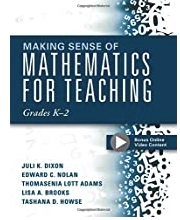 Learn how to support teachers K-2 with effective instructional practices and grow an understanding of connections in content from one grade to the next.
Learn how to support teachers K-2 with effective instructional practices and grow an understanding of connections in content from one grade to the next.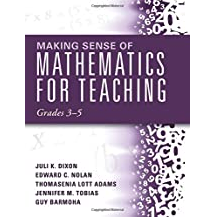 Learn how to support teachers 3-5 with effective instructional practices and grow an understanding of connections in content from one grade to the next.
Learn how to support teachers 3-5 with effective instructional practices and grow an understanding of connections in content from one grade to the next.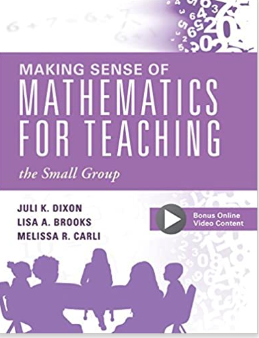 When done right, small-group instruction is a powerful tool for facilitating student understanding in K-5 mathematics. Throughout the book, best practices for small-group math instruction are addressed in detail, from planning tasks that encourage deep understanding to asking effective questions to engaging learners in meaningful conversations. Readers will learn how teaching mathematics in small groups allows you to differentiate instruction for both remediation and enrichment. The included small-group instruction videos demonstrate the suggested strategies in a real-classroom setting, giving readers the opportunity to see best practice in action.
When done right, small-group instruction is a powerful tool for facilitating student understanding in K-5 mathematics. Throughout the book, best practices for small-group math instruction are addressed in detail, from planning tasks that encourage deep understanding to asking effective questions to engaging learners in meaningful conversations. Readers will learn how teaching mathematics in small groups allows you to differentiate instruction for both remediation and enrichment. The included small-group instruction videos demonstrate the suggested strategies in a real-classroom setting, giving readers the opportunity to see best practice in action.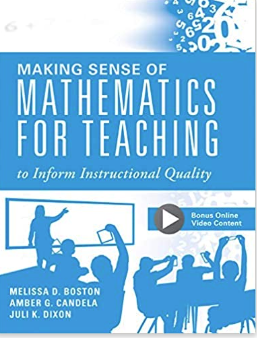 Discover a clear path for improving your instructional strategies for teaching mathematics at any grade level. Designed for individuals or collaborative teams, this practical resource introduces a set of rubrics — the Instructional Quality Assessment (IQA) Toolkit — that readers can rely on to help guide reflections, conversations, feedback, and planning. Also included is a series of short videos that showcase how to use the book’s math strategies and tools in classrooms.
Discover a clear path for improving your instructional strategies for teaching mathematics at any grade level. Designed for individuals or collaborative teams, this practical resource introduces a set of rubrics — the Instructional Quality Assessment (IQA) Toolkit — that readers can rely on to help guide reflections, conversations, feedback, and planning. Also included is a series of short videos that showcase how to use the book’s math strategies and tools in classrooms.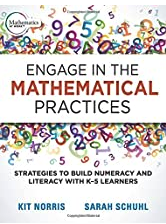 Learn strategies K-5 to promote students learning the habits of mind needed to learn mathematics content.
Learn strategies K-5 to promote students learning the habits of mind needed to learn mathematics content.- Engage in the Mathematical Practices: Strategies to Build Numeracy and Literacy with K=5 Learners. (2015)
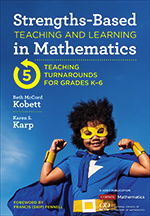 Discover a clear path for improving your instructional strategies for teaching mathematics at any grade level. Designed for individuals or collaborative teams, this practical resource introduces a set of rubrics — the Instructional Quality Assessment (IQA) Toolkit — that readers can rely on to help guide reflections, conversations, feedback, and planning. Also included is a series of short videos that showcase how to use the book’s math strategies and tools in classrooms.
Discover a clear path for improving your instructional strategies for teaching mathematics at any grade level. Designed for individuals or collaborative teams, this practical resource introduces a set of rubrics — the Instructional Quality Assessment (IQA) Toolkit — that readers can rely on to help guide reflections, conversations, feedback, and planning. Also included is a series of short videos that showcase how to use the book’s math strategies and tools in classrooms.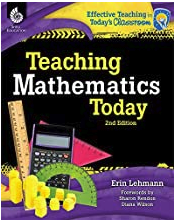 Explore research-based strategies and best practices that are highly effective in mathematics instruction.
Explore research-based strategies and best practices that are highly effective in mathematics instruction.- Teaching Mathematics Today (2015)
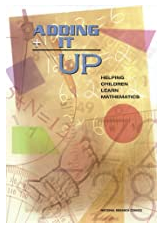 Adding It Up: Helping Children Learn Mathematics, by the National Research Council, calls for changes in curriculum, instructional materials, assessments, classroom practice, teacher preparation, and professional learning opportunities in an effort to improve mathematics teaching. Students from pre-kindergarten to grade 8 must learn to think mathematically and must think mathematically to learn.
Adding It Up: Helping Children Learn Mathematics, by the National Research Council, calls for changes in curriculum, instructional materials, assessments, classroom practice, teacher preparation, and professional learning opportunities in an effort to improve mathematics teaching. Students from pre-kindergarten to grade 8 must learn to think mathematically and must think mathematically to learn.- Adding it Up (2001)
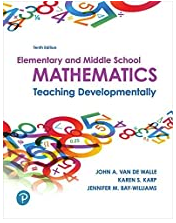 Elementary and Middle School Mathematics: Teaching Developmentally (7th ed.), by John A. Van de Walle, Karen Karp, and Jenny Bay-Williams, focuses on learning mathematics to teach mathematics. Twenty-three (23) chapters are divided into two major sections: • Teaching Mathematics: Foundations and Perspectives • Development of Mathematical Concepts and Procedures
Elementary and Middle School Mathematics: Teaching Developmentally (7th ed.), by John A. Van de Walle, Karen Karp, and Jenny Bay-Williams, focuses on learning mathematics to teach mathematics. Twenty-three (23) chapters are divided into two major sections: • Teaching Mathematics: Foundations and Perspectives • Development of Mathematical Concepts and Procedures“Big Ideas and Understandings as the Foundation for Elementary and Middle School Mathematics,” by Randall I. Charles, calls for using Big Ideas in mathematics to ground teachers’ content knowledge and teaching practices. Highly effective teachers understand the Big Ideas of mathematics and translate that to their teaching practices.
- Big Ideas and Understandings as the Foundation for Elementary and Middle School Mathematics (2005)
- Related document
The article encourages teachers to work toward continual, incremental growth in instruction. Selecting, practicing, and refining one or two strategies or skills before moving on to others promotes positive changes in teacher practice while making it easier for students to accept and adjust to the new expectations and standards being established.
Read how Krystle Hula, Assistant Principal, at LISA Academy Chenal Elementary, worked with a second grade teacher on her delivery and time management of her mathematics lessons.
Read how Kelly Krownapple, Elementary Mathematics Support Teacher from Howard County Public School System, helped a school develop a culture of writing in mathematics with the use of targeted journal prompts from Jump resources, and with their own created prompts. Through journal writing, students, teachers, and parents were able to see the growth of students’ abilities to model and reason.
Sorsha Mulroe, a math instructional support teacher, from Howard County Public School System, shares her experiences in 2nd and 4th grades using LMR (Learning Mathematics through Representations) with its use of the number line as a key representation. Read how the resultant improvement in student learning of whole numbers and fractions provided evidence for the use of this resource in all 2nd, 3rd, and 4th grades.
Read how Angela M. Waltrup, Teacher Specialist for Elementary Mathematics, Frederick County Public Schools, supports 21st Century Math Classrooms. Many elementary school leadership teams are focusing school improvement efforts on the proper integration of technology in the elementary mathematics classroom. Math specialists often have a role in coaching teachers in the use of this new technology and so must be aware of the 21st-century skills and proficiencies needed as well as how to support teachers as they develop those skills.
Because of an overwhelming demand, for how to build an effective student led classroom culture, hear from Brooke Bradley, Math Facilitator, Rogers Public Schools, how a regional professional development was created to help coaches and teachers foster vibrant student communication, collaborative work, and develop students’ ability to have empathy for others.
This is the story of how a coach, Patricia Goodman, District Math Lead Teacher, K-5, Little Rock School District, shifted her approach to supporting collaborative lesson planning, putting the power in the hands of the teachers while providing support with a process and structure for planning.
Nancy Via, Math Specialist, Arch Ford Educational Services, shares a story about helping a group of teachers find a way to work on a collaborative solution for a shared problem. She shares a protocol with a team of teachers based on their request.
